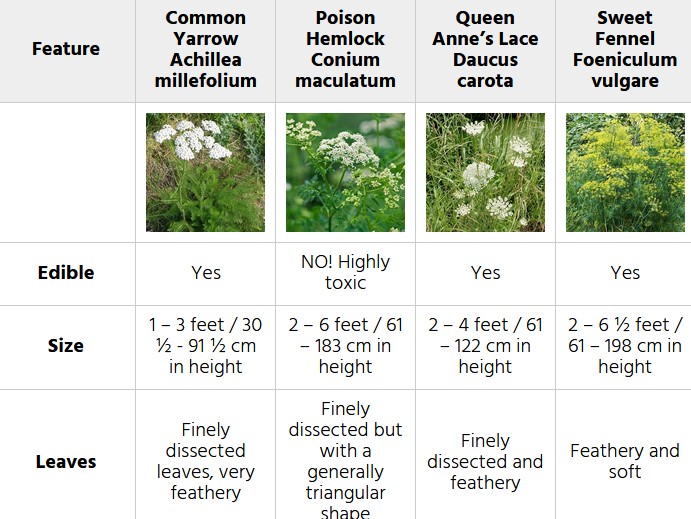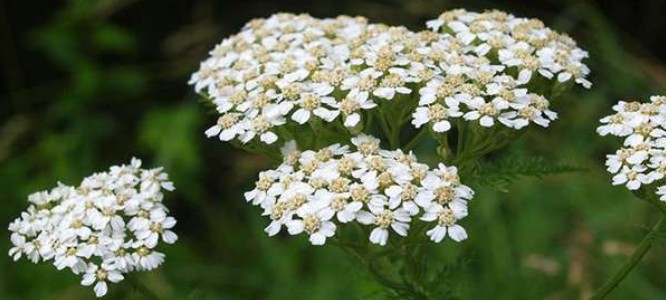 👫 Self-Sufficient Foraging from the Field of Master Mind Herbs (MMHRB) 🍃
👫 Self-Sufficient Foraging from the Field of Master Mind Herbs (MMHRB) 🍃
Shared from the research of: Joseph Mercado 👨
Article Author: Susan Elizabeth 👩
To: Herbal Lover 🌱
Blog Post #1135 📌
Re: Yarrow Plant 🌿
Date and Time: Monday, February 22, 2021 at 11:44 a.m. ⏰
Dear Herbal Lover,
Yarrow (Achillea millefolium) is a member of the daisy or Asteraceae family.
This perennial plant has numerous common names including, Milfoil, Nosebleed, Woundwort, Thousand-leaf, and – the one most often used today – Common Yarrow.
This plant is enjoyed by gardeners but is also found growing wild in meadows, in wasteland areas, and at the roadside.
While Common Yarrow blooms are white, there is now a multitude of varieties of this species that come in a range of colors.
However, this article focuses specifically on Common Yarrow.
The History of Yarrow:
This herbal plant has a rich and colorful history in folklore and medicine.
In Ancient Greece Yarrow was linked to the legendary warrior Achilles and his army who supposedly used it to staunch the bleeding from wounds.
The Ancient Romans also used this plant in the same way for their soldiers and called it herbal militaris.
Yarrow is called Biranjasipha in Sanskrit and it is used in Ayurvedic medicine in India.
In fact, it has been used as part of remedies for gastrointestinal problems for centuries.
The Druids in Ancient Britain believed that the herb also had mystic power as it was thought to help find one’s true love and to give second sight.
In North America, the Miwok, Pawnee, Cherokee, and Navajo peoples are among many that used this freely available herb for a range of health problems from pain and bleeding to colds and insomnia.
There are reports of the herb being used to treat wounds suffered by soldiers in the Civil War.
Where This Plant Is Found:
The broader Yarrow genus is native to temperate regions of Asia, Europe, and North America.
It is therefore considered to be native to Eurasia as the spread extends from China to the UK.
It has also been introduced to Australia and New Zealand, initially as a form of livestock feed. It is now naturalized and is found growing wild.
How To Identify Yarrow:
- Yarrow is not difficult to identify. One aspect that helps with identification is the scent: it is strong and sweet and described by many as like that of chrysanthemums. The bitter taste is equally powerful. These erect plants at maturity can reach a height of 1 meter / 3 ¼ feet.
- Yarrow LeafLeaf: The leaves are feathery, alternate, arranged spirally, 3 – 20 cm / 1 ¼ – 7 ¾ inches long, and evenly distributed on the stems. The leaves at the base and middle of stems are larger than the ones higher up. The leaves are hairy.
Stems: The stems are rigid, angular, and fibrous in texture. - Yarrow FlowerFlower: Yarrow blooms from the start of summer through to early fall. The individual blooms form composite flower heads. Each head consists of 15 to 40 small, round, white or pale pink flowers that have yellow centers.
Fruit: The fruits are small and contain seeds.
It is the combination of the feathery leaves and flower heads that make Yarrow easy to spot.
How To Grow Yarrow:
This medicinal plant is easy to grow.
All it really wants is the sun.
It is not fussy about soil type and does not need a lot of water (although plants in containers need more watering than those in the ground).
Grow Yarrow:
You can opt to buy small plants from a nursery or garden center or grow Yarrow yourself from seeds you purchased or harvested from your own or wild plants.
Seeds are planted in spring and shouldn’t be planted deeper than ¼ inch / ½ centimeter.
They should be 12 – 18 inches / 30 – 46 centimeters apart to allow the maturing plants the necessary space.
The seeds require sunlight and should be kept moist until they germinate.
The temperature for germination should be 18 – 240 Celsius / 64 – 750 Fahrenheit.
How To Harvest This Plant:
Yarrow can be harvested from your own plants or in the wild.
Leaves can be harvested all year and they bloom when they are mature and not beginning to fade or go to seed… unless you want the seeds!
Harvest yarrowAs with any foraging, though, you should first ensure your plant identification is correct and, secondly, that you only harvest in areas where air and soil pollution/contamination is likely to be low.
Roadsides, for example, are not good harvesting locations as both the air and ground are likely to carry toxins.
Finally, leave the roots and some basal leaves behind so that the plant can regenerate and survive.
This will mean more Yarrow for you and other foragers the following season.
What Yarrow Is Good For And The Natural Remedies Made From It:
Some of the most important active ingredients in Yarrow are asparagine, achilleine, archilletin, bitters, calcium salts, potassium, flavonoids, isovaleric acid, salicylic acid, and sterols.
It is these that are believed to give this plant its medicinal properties.
Yarrow is considered to have astringent, antiseptic, anti-bacterial, anti-inflammatory, anti-spasmodic, coagulant and – interestingly – blood thinning, diaphoretic (causes sweating), and hypotensive abilities.
It is also viewed in traditional medicine as a useful general tonic.
As a result, various Yarrow preparations are used to deal with or ease:

Which preparation you use will, as can be seen, be guided by what condition or symptom you wish to treat or ease.
It should also be noted that, while there are centuries of anecdotal evidence, there is a lack of clinical evidence of the effectiveness of Yarrow for some of these health concerns.
What Parts of The Plant Are Used In Remedies?
Most of the Yarrow plant can be used. Specifically, the roots, leaves, and flowers are all utilized.
However, the stems or stalks are not useful for remedies and neither are the seeds. In addition, the root is also not used medicinally.
A DIY Yarrow Recipe:
Yarrow tea is a frequently used way of using this herbal plant partly because it has several applications but also because it is easy to make.
So, let us look at how to make an easy recipe for making Yarrow Tincture.
While the preparation and processing are quick, you need some patience to allow the mixture to become ready.
Ingredients:
- 3 ½ tablespoons of dried Yarrow
- 10 tablespoons of >80% proof alcohol such as vodka
If you want to make a larger quantity, you can do so.
Also, some people suggest that >90% proof alcohol is preferable.
Method:
- Place the Yarrow in a suitable glass jar
- Pour the alcohol over the herb
- Gently stir the Yarrow so that it is mixed with the alcohol
- Place an airtight lid on the jar and label it clearly
- Store the jar in a cool, dark place for 6 – 8 weeks
- Strain the mixture through a sieve or kitchen muslin
Place the tincture into labeled glass dropper bottles.Yarrow Recipe – step 3
The alcohol acts as an excellent preservative; you can keep and use the tincture for 12 – 18 months.
However, if you notice a change in the tincture’s aroma, color, or taste then it is better to get rid of it.
Dosage:
As with any herbal preparation, how much you use depends on both general and personal factors including:
- An individual’s age
- A person’s general health: existing medical conditions and current medications
- What condition requires treatment
- Which remedy will be used to treat or ease the condition.
There are a few guidelines, though. For example, you can enjoy 1 – 3 cups of Yarrow Tea daily.
A tincture of the strength described in the recipe can be taken in water 1 – 3 times a day in doses of 20 – 40 drops.
The bottom line is that any remedy, including plant-based ones, must be taken as directed by a healthcare practitioner or by the manufacturer.
How To Preserve This Plant:
Yarrow flowers and leaves are best preserved by drying as this retains their medicinal properties and extends their shelf-life.
The drying process is straightforward:
- Spread out the flower heads in a thin/single layer on a drying screen, wire mesh, or suitable cloth
- Place the screen/cloth/rack in a well ventilated and shaded place
- Turn or move the flower heads around regularly so that they are all exposed to air
- When the flowers and leaves are dry (crisp to the touch) place them in airtight and labeled containers
- Store the containers in a dark, dry place.
Do not wash the flowers as this will greatly increase the chances of the flowers molding or getting mildewed before they dry.
If this happens you must throw them away.
Correctly dried and stored, the plant material should stay fresh and potent for up to a year.
What Plants Resemble Yarrow?

There are a few plants that are said to resemble Yarrow. However, there are some features – including aroma – that can help to avoid errors in identification.
Many people, though, do not find it hard to identify Common Yarrow thanks to the key differences when compared to potential look-alikes:
The possible confusion in relation to Sweet Fennel only lasts until it begins to bloom as it is the only one that doesn’t have white blooms.
Warning and Cautions:
Just because a remedy is natural or plant-based does not necessarily mean that it is without the risk or safe for everybody.
Certain individuals should avoid Yarrow altogether unless it has been approved by a healthcare practitioner:
- Pregnant and breastfeeding women
- Women trying to fall pregnant
- Men trying to father a baby
- Those with bleeding disorders
- Individuals who are allergic to plants in the daisy family which includes daisies, marigolds, ragweed, chrysanthemums, etc.
- People who are scheduled for surgery should stop taking Yarrow 2 weeks before the procedure
Those on certain medications:
- Blood thinners
- Lithium
- Sedatives / barbiturates
- Some antacids (this is rare)
- Those that reduce gastric acid / H2-blockers
If you experience any unpleasant reaction, stop taking Yarrow immediately.
If you are at all unsure, consult your healthcare provider before using this plant.
Finally, it should also be noted that Yarrow is toxic to several types of domesticated animals including dogs, cats, and horses.
It is therefore not advisable to grow Yarrow in your garden if you have a pet that chews plants.
Content Source: The Lost Herbs

 Email Us a Message
Email Us a Message 

Please send us a personal message below and we will serve you momentarily.
We appreciate you visiting the MMU Global Research Directory
For more blog posts, videos, and to generate more knowledge, please free and…




 Fly Over to the MMU Facebook Page with Hoot
Fly Over to the MMU Facebook Page with Hoot 

 Visit the MMU Facebook Group Today
Visit the MMU Facebook Group Today 
 Claim Your Own 32GB I-CHIP Think Drive Here for Only $67
Claim Your Own 32GB I-CHIP Think Drive Here for Only $67 
 Get 42 Nuggets of Knowledge: (12) MP4’s
Get 42 Nuggets of Knowledge: (12) MP4’s  + (12) MP3’s
+ (12) MP3’s  + (8) PDF’s
+ (8) PDF’s  + (5) HTM’s
+ (5) HTM’s  + (5) TXT Files
+ (5) TXT Files